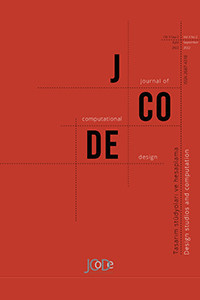Dijital Fabrikasyon Süreçlerinde Sanal Gerçekliğin Kitlesel Bireyselleştirmeye Dönük Kullanımı
Kitlesel bireyselleştirme, Dijital fabrikasyon, Sanal gerçeklik, Antropometri, Boyutsal bireyselleştirme
The Use of Virtual Reality for Mass Customization in Digital Fabrication Processes
Mass customization, Digital fabrication, Virtual reality, Anthropometry, Dimensional customization,
___
- Behara, D. N. & Das, B. (2012). Structural anthropometric measurements of the Canadian adult population: The fallacy of the ‘average person’ concept. Theoretical Issues in Ergonomics Science, 13(3), 380-392. https://doi.org/10.1080/1463922X.2010.505271
- Burke, E. (1909). On the Sublime and Beautiful. P.F. Collier&Son Company, https://www.bartleby.com/24/2/
- Caan, S. (2011). Rethinking design and interiors. Laurence King Publishing.
- Crane, T., & Patterson, S. (Eds.). (2012). History of the mind-body problem. Routledge.
- Desirenhos. (2014, Feb 9). Disturbing neufert. Retrieved Jan 21, 2022, https://desirenhos.wordpress.com/2014/09/02/disturbing-neufert-2/
- Dunn, N. (2012). Digital fabrication in architecture. Laurence King Publishing.
- Francalanci, E. L., (2012). The aesthetic of the objects [Nesnelerin estetiği]. Dost Bookstore Publishing.
- Franco, T. F. (2019). Understanding the human body: designing for people of all shapes and sizes. Archdaily. Retrieved Jan 21, 2022, https://www.archdaily.com/903027
- Fuchs, P., Moreau G. & Guitton, P. (Ed.). (2011). Virtual Reality: Concepts and Technologies. CRC Press.
- Gallagher, S., & Zahavi, D. (2013). The phenomenological mind. Routledge, https://doi.org/10.4324/9780429319792
- Garip, E., Onay, N. S. & Garip, S. B. (2021). A model for mass customization and flexibility in mass housing units. Open House International, 46(4), 636-650. https://doi.org/10.1108/OHI-02-2021-0053
- Gürer, E. (2014). The phenomenology of computational thinking in design. (Thesis No. 355967) [Doctoral dissertation (355967), Istanbul Technical University]. Council of Higher Education Thesis Center [Yükseköğretim Kurumu Başkanlığı Tez Merkezi]. https://tez.yok.gov.tr/UlusalTezMerkezi/tezSorguSonucYeni.jsp
- Hertzberg, H. T. E. (1970). Avarage man is a fiction: range of sizes is key to efficient workplaces. Contract Publishing.
- Husserl, E. (1970). The crisis of European sciences and transcendental phenomenology. Northwestern University Press.
- Khalili-Araghi, S. & Kolarevic, B. (2020). Variability and validity: flexibility of a dimensional customization system. Automation in Construction, Vol. 109, 1-19. https://doi.org/10.1016/j.autcon.2019.102970
- Kolarevic, B. (2003). Architecture in the digital age: design and manufacturing. Spon Press.
- Panero, J. & Zelnik, M. (1979). Human dimension & interior space. Watson-Guptill Publications.
- R. Duray, P.T. Ward, G.W. Milligan. & W.L. Berry. (2000). Approaches to mass customization: configurations and empirical validation, J. Oper. Manag, 18 (6), 605–625. https://doi.org/10.1016/S0272-6963(00)00043-7
- Shirazi, M. R. (2014). Towards an articulated phenomenological interpretation of architecture. Routledge Taylor and Francis Group.
- The Architectural Review. (2018, Sep 26). Folio: Sarah Wigglesworth’s dining tables. Retrived Jan 21, 2022, https://www.architectural-review.com/essays/folio/folio-sarah-wigglesworths-dining-tables, (Url-3).
- Toffler, A. (1970). Future Shock. Bantam Books.
- Yayın Aralığı: Yılda 2 Sayı
- Başlangıç: 2019
- Yayıncı: İstanbul Teknik Üniversitesi
Deneysel Tiyatro Sahnelerine Parametrik Biçim Grameri ile Sahne-Parter Düzeni Önerilmesi
Mimarlıkta Dijital Fabrikasyonun Sanatsal ve Şiirsel Boyutu
Kamile ÖZTÜRK KÖSENCİĞ, Yağmur Burcu GÜNEŞ
Dijital Fabrikasyon Süreçlerinde Sanal Gerçekliğin Kitlesel Bireyselleştirmeye Dönük Kullanımı
Çekişmeli Üretken Ağlar ile Plan Üretimi: Haeckel'in Çizimlerinden Palladyan Planlara
Mimaride Eklemeli Üretim Sistemlerinin Sınıflandırması için bir Öneri
Sandalye Tasarımında Üretken Çözümlerin Tasarımcısı Olarak Makine
